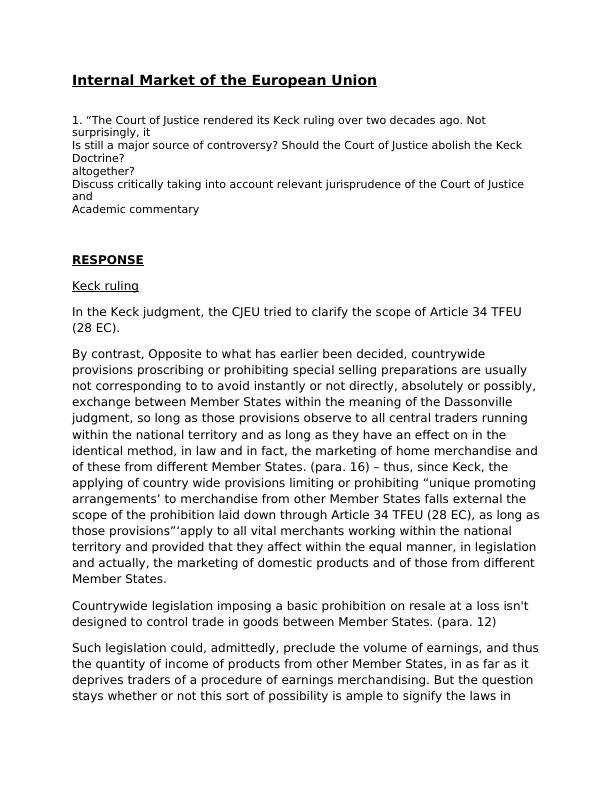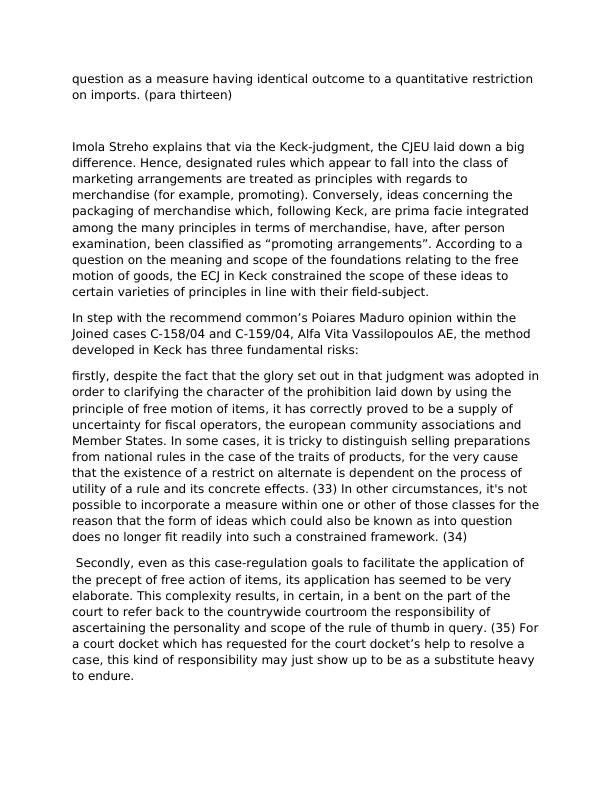Ask a question from expert
Internal Market of the European Union Assignment
7 Pages2056 Words245 Views
Added on 2019-12-04
Internal Market of the European Union Assignment
Added on 2019-12-04
BookmarkShareRelated Documents
Internal Market of the European Union1. “The Court of Justice rendered its Keck ruling over two decades ago. Not surprisingly, itIs still a major source of controversy? Should the Court of Justice abolish the Keck Doctrine?altogether?Discuss critically taking into account relevant jurisprudence of the Court of Justice andAcademic commentaryRESPONSEKeck rulingIn the Keck judgment, the CJEU tried to clarify the scope of Article 34 TFEU (28 EC).By contrast, Opposite to what has earlier been decided, countrywide provisions proscribing or prohibiting special selling preparations are usually not corresponding to to avoid instantly or not directly, absolutely or possibly,exchange between Member States within the meaning of the Dassonville judgment, so long as those provisions observe to all central traders running within the national territory and as long as they have an effect on in the identical method, in law and in fact, the marketing of home merchandise andof these from different Member States. (para. 16) – thus, since Keck, the applying of country wide provisions limiting or prohibiting “unique promotingarrangements’ to merchandise from other Member States falls external the scope of the prohibition laid down through Article 34 TFEU (28 EC), as long asthose provisions”‘apply to all vital merchants working within the national territory and provided that they affect within the equal manner, in legislationand actually, the marketing of domestic products and of those from different Member States.Countrywide legislation imposing a basic prohibition on resale at a loss isn't designed to control trade in goods between Member States. (para. 12)Such legislation could, admittedly, preclude the volume of earnings, and thusthe quantity of income of products from other Member States, in as far as it deprives traders of a procedure of earnings merchandising. But the question stays whether or not this sort of possibility is ample to signify the laws in

question as a measure having identical outcome to a quantitative restriction on imports. (para thirteen)Imola Streho explains that via the Keck-judgment, the CJEU laid down a big difference. Hence, designated rules which appear to fall into the class of marketing arrangements are treated as principles with regards to merchandise (for example, promoting). Conversely, ideas concerning the packaging of merchandise which, following Keck, are prima facie integrated among the many principles in terms of merchandise, have, after person examination, been classified as “promoting arrangements”. According to a question on the meaning and scope of the foundations relating to the free motion of goods, the ECJ in Keck constrained the scope of these ideas to certain varieties of principles in line with their field-subject.In step with the recommend common’s Poiares Maduro opinion within the Joined cases C-158/04 and C-159/04, Alfa Vita Vassilopoulos AE, the method developed in Keck has three fundamental risks:firstly, despite the fact that the glory set out in that judgment was adopted inorder to clarifying the character of the prohibition laid down by using the principle of free motion of items, it has correctly proved to be a supply of uncertainty for fiscal operators, the european community associations and Member States. In some cases, it is tricky to distinguish selling preparations from national rules in the case of the traits of products, for the very cause that the existence of a restrict on alternate is dependent on the process of utility of a rule and its concrete effects. (33) In other circumstances, it's not possible to incorporate a measure within one or other of those classes for thereason that the form of ideas which could also be known as into question does no longer fit readily into such a constrained framework. (34) Secondly, even as this case-regulation goals to facilitate the application of the precept of free action of items, its application has seemed to be very elaborate. This complexity results, in certain, in a bent on the part of the court to refer back to the countrywide courtroom the responsibility of ascertaining the personality and scope of the rule of thumb in query. (35) Fora court docket which has requested for the court docket’s help to resolve a case, this kind of responsibility may just show up to be as a substitute heavy to endure.

Thirdly, it has been obvious that the rule in Keck and Mithouard is just not without difficulty transposed into the fields of the opposite freedoms of action. The courtroom has by no means in fact adopted the “promoting association” classification in its case-regulation in the case of the opposite freedoms. In such circumstances, it only most often regards as restrictions on freedom of action ‘all measures which restrict, hinder or render much lessattractive the endeavor of that freedom’. (36) This change in process raises a hindrance of consistency in the case-legislation. This situation seems to be even bigger as many national measures examined via the court from the viewpoint of the free action of items may also be dealt with as restrictions onthe opposite freedoms of motion. (37) It follows from the above that even though Keck and Mithouard was intended to limit the number of actions and to restrain the excesses which resulted from the application of the precept offree action of goods, sooner or later it raises the quantity of questions about the specified scope of the precept. Yet is there motive to abandon this case-legislation? I do not feel so. Nevertheless, it is main to make clear it, in certain by way of reference to thecase-legislation developed in the other fields of free motion. In para. 14 of the Keck-judgment, the ECJ defined that Article 34 TFEU (28 EC) was not an adequate basis for the moves of merchants wishing to ‘mission any principles whose result is to restrict their industrial freedom even where suchrules are usually not geared toward products from other Member States.Advocate general Poiares Maduro continues within the Joined instances C-158/04 and C-159/04, Alfa Vita Vassilopoulos AE:b) software of the Keck standards to arrangements to be used:nonetheless, because the Dassonville system is so extensive, eventually any countrywide principles limiting the use of a product could also be labeled as a measure having an identical effect and must be justified.The question for this reason arises which the court additionally raised – albeitin yet another connection – in its judgment in Keck, which is whether or not any measure which potentially also influences the quantity of sales of products from other Member States can also be characterised as a measure having identical outcome. (19)It turns into clear that this query involving preparations for use, that is to saycountrywide principles governing how and the place merchandise could also

End of preview
Want to access all the pages? Upload your documents or become a member.
Related Documents
European Union Lawlg...
|5
|659
|53
European Union Law: Cassis de Dijon and The Keck Case-Lawlg...
|5
|791
|72